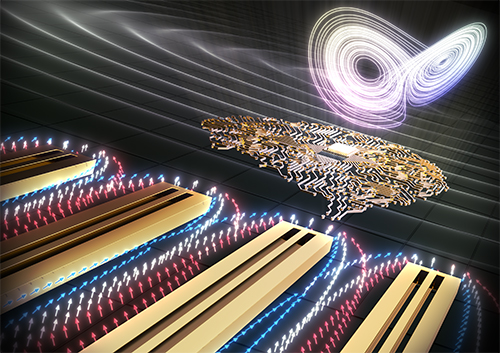- Home
- > Research
- > Research Highlights
- > Vol. 85 ・・・
 Research Highlights
Research Highlights
[Vol. 85]
High-performance Physical Reservoir Computing with Multi-detection Chaotic Spin Wave Interference
Researchers from the Research Center for Materials Nanoarchitectonics (MANA) present the first experimental demonstration of a physical reservoir computing system based on spin wave interference.

Novel technologies are shaping the modern world, and artificial intelligence (AI) systems are expected to play an important role in this transformation. Accordingly, demand for compact AI devices with low power consumption and high computational performance is growing rapidly. Recently, physical reservoir computing, which relies on a physical system to efficiently process information, has emerged as a promising technology for ubiquitous AI implementation. To be considered suitable for reservoir computing, the physical system must possess nonlinearity, short-term memory, and the ability to map in high dimensions. Notably, spin wave interference in ferromagnetic materials satisfies all three criteria and is considered a promising candidate for efficient reservoir computing. However, its experimental realization has remained elusive so far.
Now, a research team led by Principal Investigator Kazuya Terabe from MANA has experimentally demonstrated a reservoir computing system based on multi-detection nonlinear spin wave interference for the first time. Their study involved Dr. Wataru Namiki as the first author and Dr. Takashi Tsuchiya as the corresponding author.
The team utilized an yttrium iron garnet single crystal with multi-antennas, which excited and detected multi-spin waves. The physical reservoir computing system showed excellent performance for a hand-written digit recognition task, second-order nonlinear dynamical tasks, and nonlinear autoregressive moving average (NARMA); specifically, a maximum testing accuracy rate of 89.6% for hand-written digit recognition and normalized mean square errors (MSEs) of 8.37 x 10 to the power of minus 5 and 1.81 x 10 to the power of minus 2 for the nonlinear dynamical tasks and NARMA2, respectively. Notably, the MSEs are the best figures reported for any experimental physical reservoir.
"The high performance can be attributed to a high nonlinearity and a large memory capacity of the multi-detection chaotic spin wave interference system. It can thus contribute to the implementation of integrated physical reservoir systems with real-world applications," concludes Dr. Tsuchiya.
Now, a research team led by Principal Investigator Kazuya Terabe from MANA has experimentally demonstrated a reservoir computing system based on multi-detection nonlinear spin wave interference for the first time. Their study involved Dr. Wataru Namiki as the first author and Dr. Takashi Tsuchiya as the corresponding author.
The team utilized an yttrium iron garnet single crystal with multi-antennas, which excited and detected multi-spin waves. The physical reservoir computing system showed excellent performance for a hand-written digit recognition task, second-order nonlinear dynamical tasks, and nonlinear autoregressive moving average (NARMA); specifically, a maximum testing accuracy rate of 89.6% for hand-written digit recognition and normalized mean square errors (MSEs) of 8.37 x 10 to the power of minus 5 and 1.81 x 10 to the power of minus 2 for the nonlinear dynamical tasks and NARMA2, respectively. Notably, the MSEs are the best figures reported for any experimental physical reservoir.
"The high performance can be attributed to a high nonlinearity and a large memory capacity of the multi-detection chaotic spin wave interference system. It can thus contribute to the implementation of integrated physical reservoir systems with real-world applications," concludes Dr. Tsuchiya.
Reference
“Experimental Demonstration of High-Performance Physical Reservoir Computing with Nonlinear Interfered Spin Wave Multidetection”
Wataru Namiki, Daiki Nishioka, Yu Yamaguchi, Takashi Tsuchiya and Kazuya Terabe
Journal: Advanced Intelligent Systems (August 22, 2023)
DOI : doi.org/10.1002/aisy.202300228
Wataru Namiki, Daiki Nishioka, Yu Yamaguchi, Takashi Tsuchiya and Kazuya Terabe
Journal: Advanced Intelligent Systems (August 22, 2023)
DOI : doi.org/10.1002/aisy.202300228
Affiliations
Research Center for Materials Nanoarchitectonics (MANA), National Institute for Materials Science (NIMS), Namiki 1-1, Tsukuba, Ibaraki 305-0044, Japan
Contact information
Research Center for Materials Nanoarchitectonics (MANA)
National Institute for Materials Science
1-1 Namiki, Tsukuba, Ibaraki 305-0044 Japan
Phone: +81-29-860-4710
E-mail: mana-pr[AT]nims.go.jp
1-1 Namiki, Tsukuba, Ibaraki 305-0044 Japan
Phone: +81-29-860-4710
E-mail: mana-pr[AT]nims.go.jp

